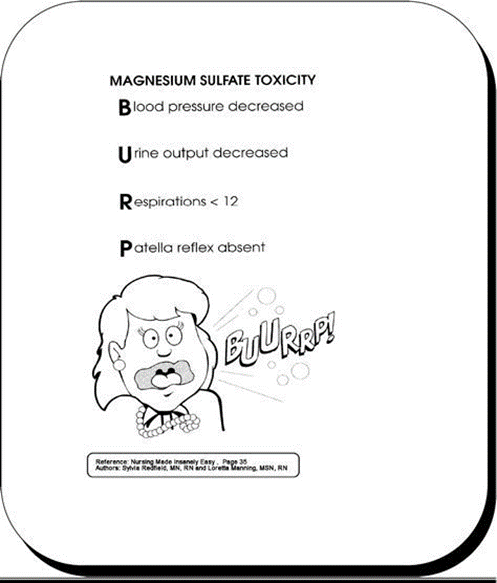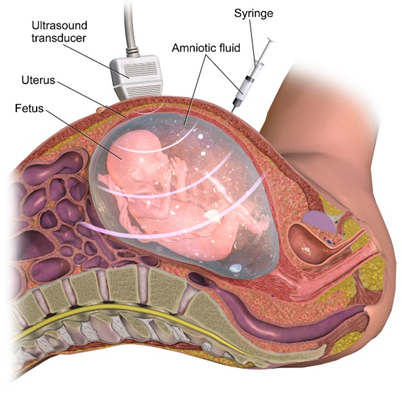A nurse is assessing a client who received magnesium sulfate to treat preterm labor. Which of the following clinical findings should the nurse identify as an indication of toxicity of magnesium sulfate therapy and report to the provider?
Drowsiness
Facial flushing
Nausea
Respiratory depression
The Correct Answer is D
Explanation:
A. Drowsiness: Mild drowsiness is a common side effect of magnesium sulfate therapy and is not necessarily indicative of toxicity. However, severe drowsiness or lethargy can be a sign of magnesium toxicity and should be reported to the provider.
B. Facial flushing: Facial flushing is a common side effect of magnesium sulfate administration and is generally not a sign of toxicity. It is often accompanied by warmth and redness of the skin but is not considered a serious adverse reaction.
C. Nausea: Nausea is another common side effect of magnesium sulfate therapy and is usually mild and transient. It is not typically indicative of toxicity unless it is severe and persistent.
D. Respiratory depression: Respiratory depression is a critical sign of magnesium toxicity. Excessive levels of magnesium can affect neuromuscular function, leading to respiratory muscle weakness and depression. This can result in shallow or slowed breathing, decreased oxygenation, and potential respiratory failure. Respiratory depression is a serious complication that requires immediate intervention, and the nurse should report it to the provider promptly.

Nursing Test Bank
Naxlex Comprehensive Predictor Exams
Related Questions
Correct Answer is C
Explanation
Explanation:
A. Braxton Hicks contraction
Braxton Hicks contractions are often referred to as "practice" contractions and are common during pregnancy. They are typically irregular and do not cause cervical changes. While discomfort after an amniocentesis procedure can sometimes trigger Braxton Hicks contractions, they are not usually a cause for immediate concern unless they become frequent, intense, or are accompanied by other signs of preterm labor, such as regular contractions, lower back pain, pelvic pressure, or changes in vaginal discharge.
B. Amniotic fluid contains fetal urine
The presence of fetal urine in the amniotic fluid is a normal and expected process during pregnancy. Fetal urine production contributes to the volume and composition of amniotic fluid, helping maintain the environment in the uterus and supporting fetal development. This finding is not directly related to the client's discomfort after an amniocentesis procedure and is not a cause for immediate concern unless there are other complications or abnormalities related to the amniotic fluid composition.
C. Prolonged vaginal bleeding
Prolonged vaginal bleeding after an amniocentesis procedure is a significant finding that requires immediate attention. While some spotting or mild bleeding can occur after the procedure, prolonged or significant bleeding may indicate complications such as uterine injury, placental abruption, or other issues that need urgent assessment and intervention by healthcare providers.

D. Lab results reveal abnormal chromosome cells
Abnormal chromosome cells found in the amniotic fluid sample obtained during amniocentesis may indicate genetic abnormalities or conditions in the fetus. While this finding is significant and requires follow-up and further evaluation, it is not an immediate concern in terms of the client's discomfort or the need for priority action by the nurse unless it is associated with other urgent clinical signs or symptoms.
Correct Answer is C
Explanation
Explanation:
A. "A gain of about 1 pound per week is the best pattern for you."
This response suggests a weight gain pattern rather than a total recommended weight gain for the entire pregnancy. A gain of about 1 pound per week would typically align with the recommended weight gain for individuals with a normal pre-pregnancy BMI (Body Mass Index). However, for someone with an overweight BMI (BMI 25 to 29.9), this rate of weight gain might be higher than the recommended range. Therefore, it may not be the best pattern for the client with a BMI of 26.5.
B. "It would be best if you gained about 11 to 20 pounds."
This response provides a weight gain range that is more appropriate for individuals with an obese BMI (BMI 30 or higher) rather than those with an overweight BMI. The recommended weight gain for someone with an overweight BMI is higher than 11 to 20 pounds. Therefore, this response underestimates the recommended weight gain for the client with a BMI of 26.5.
C. "The recommendation for you is about 15 to 25 pounds."
This response aligns with the recommended weight gain range for individuals with an overweight BMI (BMI 25 to 29.9). According to the Institute of Medicine (IOM) guidelines, the recommended weight gain for someone with an overweight BMI is about 15 to 25 pounds during pregnancy. This choice accurately reflects the appropriate recommendation for the client with a BMI of 26.5.
D. "A gain of about 25 to 35 pounds is recommended for you."
This response suggests a weight gain range that is more appropriate for individuals with a normal pre-pregnancy BMI (BMI 18.5 to 24.9). The recommended weight gain for someone with an overweight BMI is lower than 25 to 35 pounds. Therefore, this response overestimates the recommended weight gain for the client with a BMI of 26.5.
Whether you are a student looking to ace your exams or a practicing nurse seeking to enhance your expertise , our nursing education contents will empower you with the confidence and competence to make a difference in the lives of patients and become a respected leader in the healthcare field.
Visit Naxlex, invest in your future and unlock endless possibilities with our unparalleled nursing education contents today
Report Wrong Answer on the Current Question
Do you disagree with the answer? If yes, what is your expected answer? Explain.
Kindly be descriptive with the issue you are facing.
